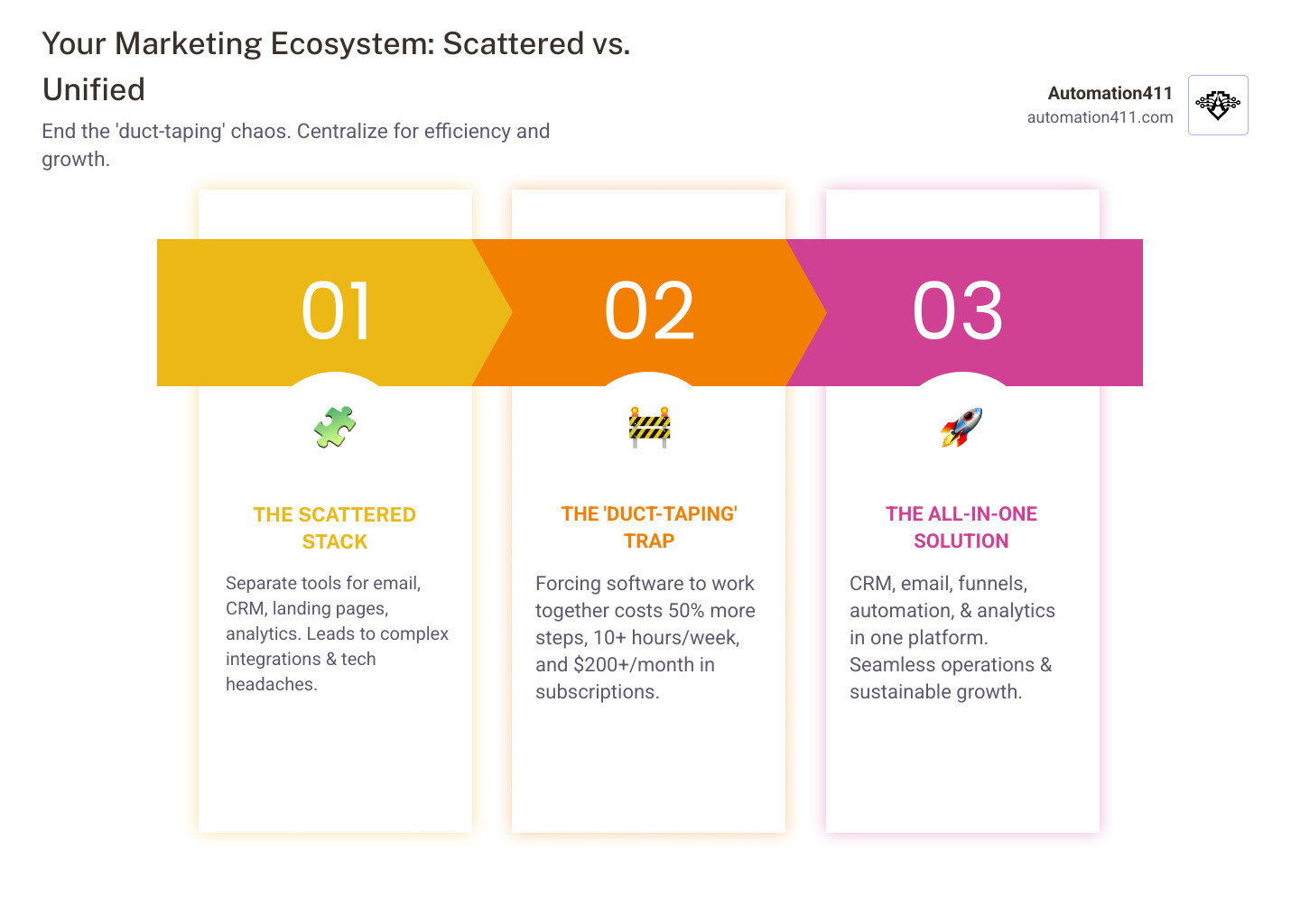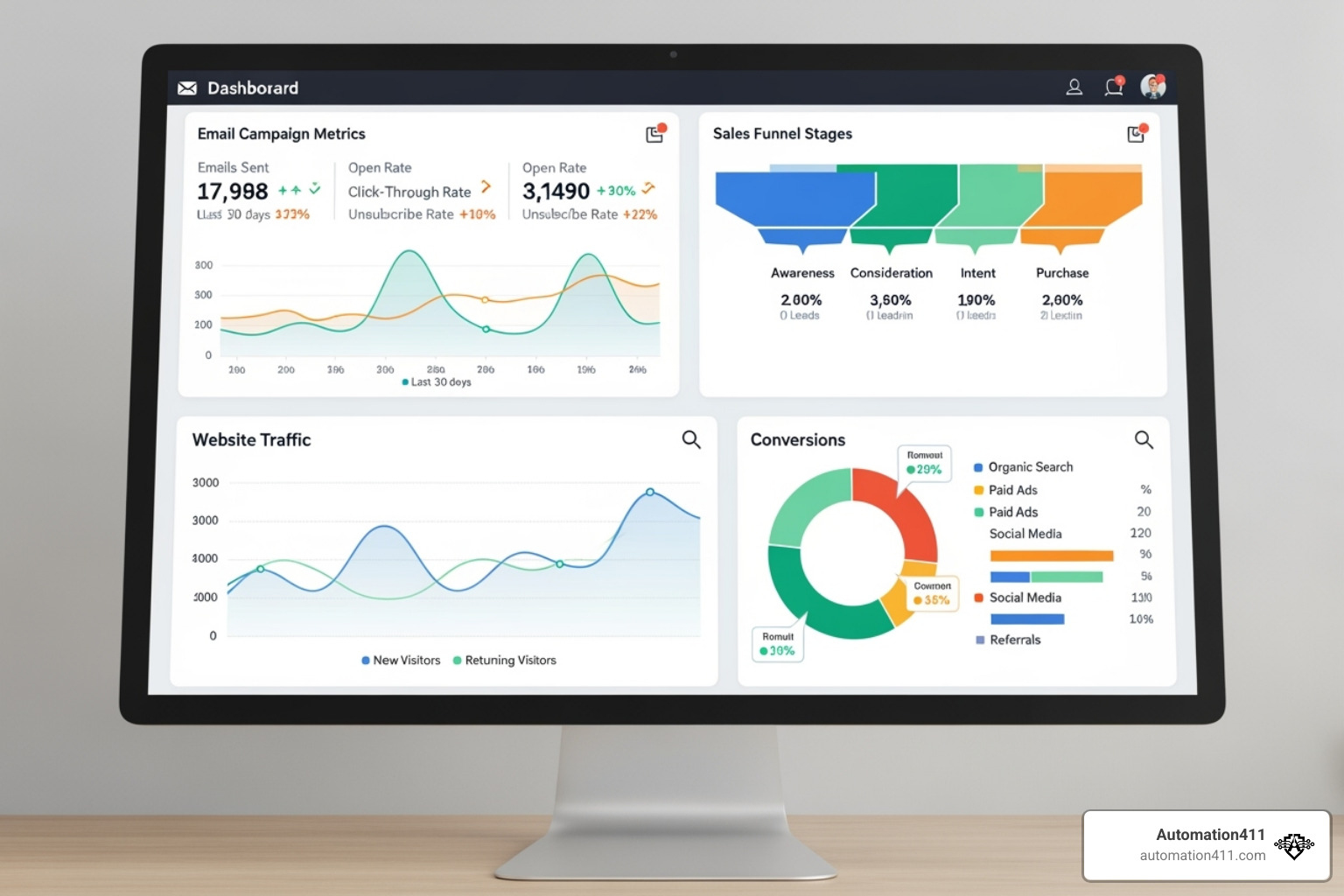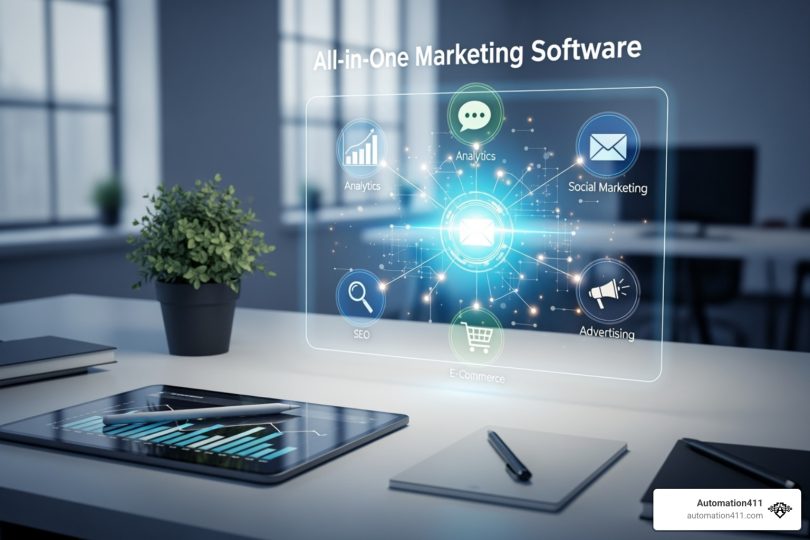Why All-in-One Marketing Software is the Future of Business Growth
All-in-one marketing software is a unified platform that consolidates tools like email marketing, CRM, landing pages, and analytics into a single system. This eliminates the need to juggle separate subscriptions and complex integrations.
Quick Answer: What You Need to Know
- What it is: A platform combining CRM, email, funnels, automation, and analytics.
- Key benefit: Save thousands annually by replacing multiple tools with one subscription.
- Time savings: Business owners save 10+ hours weekly by avoiding software “duct-taping.”
- Best for: Small businesses, solopreneurs, and creators needing streamlined operations.
- Core features: Email marketing, sales funnels, website builder, CRM, and automation.
Running a small business means managing customer relationships, email campaigns, landing pages, and analytics. The problem is that most businesses use separate tools for each function: one for email, another for a CRM, a third for landing pages, and so on.
This fragmented approach, or “duct-taping,” forces different software to work together through complex integrations and broken plugins. Using separate tools can require 50% more steps than a unified system.
The solution is an all-in-one marketing software that brings everything under one roof. Your customer data, communication tools, sales funnels, and analytics live in a single dashboard. No more switching between tabs or paying for five different subscriptions when one can do it all.
Industry data shows businesses using separate tools can spend $221+ per month for basic functionality (landing pages, email, course hosting). In contrast, comprehensive all-in-one solutions offer these features for a fraction of the cost.

The Core Benefits of an All-in-One Marketing Software
Imagine opening a single dashboard that shows your email campaigns, customer data, sales funnels, and analytics—all in one place. That’s what all-in-one marketing software delivers.
The magic isn’t just convenience; it’s about changing how your business operates. Consolidating your marketing tools into one system open ups efficiency gains, slashes costs, and helps create connected customer experiences.
Businesses typically save thousands of dollars per year by switching. It’s simple math: when you eliminate multiple subscriptions and integration fees, the savings add up. More importantly, business owners report getting back 10+ hours per week by not wrestling with disconnected software. That’s time you can spend on strategy or connecting with customers.
When all your customer data lives in one system, your marketing becomes smarter and more targeted. Your customers notice the difference, which translates to better retention. As your business grows, an all-in-one marketing software grows with you, supporting your ambitions without stressful migrations.
Streamline Operations to Save Time and Money
Many entrepreneurs spend hours playing tech support for their own marketing stack, troubleshooting broken plugins and duct-taping software together.
Consolidating subscriptions into an all-in-one platform saves you in two ways. First, you save money. Businesses often pay $221+ per month for separate tools like a landing page builder ($95/mo), email marketing ($20/mo), and course hosting ($99/mo). With a comprehensive platform, you’re replacing multiple tools with one subscription at a fraction of the cost.
Second, you get your time back. Those 10+ hours per week are saved by not logging into different dashboards, exporting and importing data, or troubleshooting sync issues. Instead, everything lives under one roof. Your landing pages connect to email sequences, which update your CRM and feed into your analytics. It just works.
Most platforms are designed with intuitive drag-and-drop builders and pre-built templates, so you don’t need to be tech-savvy. When you calculate your return on your investment, this is where all-in-one marketing software truly shines.
Centralize Data for a Superior Customer Experience
Your customers care about feeling understood, not about your tech stack. Delivering that experience is nearly impossible when your data is scattered across multiple platforms.
When you centralize data in an all-in-one system, you get a unified customer view. You can see where someone is in their journey: Did they open your last email? Download a lead magnet? It’s all there, giving you the complete story.
This visibility allows for personalized communication that feels genuinely helpful. You can segment your audience based on behavior and send targeted campaigns. It also ensures consistent branding across channels. With everything in one system, your brand voice remains cohesive across emails, landing pages, and other touchpoints.
The real power comes from tracking the full customer journey. You can see which touchpoints work and optimize accordingly. This insight helps you serve customers better, leading to improved customer retention. When your marketing is connected, your customer experience is too.
Drive Scalable Growth with a Unified Platform
Outgrowing your systems is a common anxiety for business owners. Your email provider caps your contacts, or your landing page builder slows down, forcing a painful migration right when you’re gaining momentum.
All-in-one marketing software eliminates this problem. These platforms are built with scalability in mind, designed to grow with your business.
Need a new feature? It’s often already there or available as a seamless add-on. There are no complex migrations or data transfers to worry about. The platform simply expands to meet your needs for more contacts, data, or team members. You’re not constantly hitting arbitrary limits.
This is what supporting business scalability truly means. You invest once in a solid foundation that supports whatever you build on top of it, whether it’s a membership site, online course, or affiliate program. Knowing you won’t need to switch platforms as you expand is freeing. You can focus on strategy and growth, not on managing another software transition.
Must-Have Features in a Modern Marketing Platform
When evaluating all-in-one marketing software, it’s important to know what’s under the hood. A comprehensive platform should cover every stage of the customer journey from a single dashboard, eliminating tab overload.
Let’s walk through the features you should expect from a modern marketing platform, from the essentials to more advanced tools.

Core Functionality for Every Business
These are the non-negotiable features any all-in-one marketing software should include.
- Customer Relationship Management (CRM): This is the nerve center of your customer operation. It tracks interactions, stores contact details, and monitors leads in your sales process, giving you a full view of each customer’s journey.
- Email Marketing: A solid platform lets you craft campaigns, build subscription forms, segment your audience, and track engagement. Many offer unlimited sending, which saves a fortune as your list grows.
- Landing Page and Funnel Builder: These are your conversion machines. Landing pages capture leads and make sales, while funnels guide visitors toward taking action. Most platforms offer drag-and-drop builders, so no coding is required.
- Website Builder: For many businesses, a simple, effective website connected to your marketing tools is essential. It becomes a seamless extension of your marketing efforts.
- Analytics and Reporting: Consolidated reporting provides clear insights into campaign performance and customer behavior, helping you measure return on your investment without piecing together data from multiple sources.
For more details on budgeting, see our guide on How Much Does an All-in-One Platform Cost?.
The Power of Automation in All-in-One Marketing Software
Automation transforms all-in-one marketing software from a helpful tool into a game-changer. Imagine repetitive tasks like sending welcome emails, following up with leads, and reminding customers about abandoned carts all happening automatically.
- Automated Workflows: When a new lead signs up, the system can send a welcome email, add the lead to a list, and schedule a follow-up sequence without you clicking a button.
- Lead Nurturing Sequences: Set up multi-step email sequences that deliver valuable content over time, building relationships and guiding prospects toward a purchase. You set it up once, and it runs forever.
- Trigger-Based Actions: The system can respond to customer actions. If someone abandons a cart, they get a reminder. If they visit a pricing page multiple times, they might receive a targeted offer.
- Behavioral Targeting: By tracking user interactions, the platform automatically segments your audience and delivers relevant messages.
- Sales Pipeline Automation: Leads move through stages automatically, tasks get assigned, and follow-ups go out on schedule, ensuring no prospect slips through the cracks.
Sophisticated automation rules mean you can build entire sales funnels, set up complex marketing sequences, sell products, and receive payments without constantly managing the technical details. This eliminates the extra steps that plague businesses using separate tools.
Advanced Tools for Experts and Creators
Many platforms offer advanced tools for experts, course creators, and coaches.
- Membership Sites: Host private content, manage access, create membership tiers, and build recurring revenue. Everything is password-protected and integrated with your payment system.
- Online Course Hosting: Create, host, and sell complete online courses. This includes video hosting, organizing lessons, tracking student progress, and issuing certificates.
- Affiliate Program Management: Turn customers into an extended sales force. Recruit affiliates, track their sales with unique links, and manage payouts from your dashboard.
- Advanced Sales Funnels: Implement one-click upsells, order bumps at checkout, and A/B testing to improve conversion rates and increase average order value.
- Video Hosting: Many platforms include video hosting, so you can upload videos directly to your pages and courses without needing a separate service.
To see these features in action, check out our All-in-One Platform Review & Walkthrough.
Choosing the Right Platform for Your Business
Picking the right all-in-one marketing software is about finding the one that aligns with where your business is now and where it’s headed. Think of it as choosing a business partner: you want someone reliable, compatible, and committed to growing with you. The right choice transforms how you work, while the wrong one leads to frustration.
At Automation411, we’ve helped countless business owners steer this decision. With the right approach, you can find a platform that truly serves you.
How to Evaluate an All-in-One Marketing Software
Before committing, take a systematic approach to evaluating your options to match the platform’s strengths with your business’s needs.
- Assess your specific needs: What are you trying to accomplish? List your must-have features to avoid paying for things you’ll never use.
- Prioritize ease of use: A powerful platform is useless if you can’t figure it out. Look for intuitive interfaces and drag-and-drop builders. You shouldn’t need coding skills.
- Check for scalability: Your business will grow, so ensure the platform can grow with you. It should handle more contacts and complex automation without forcing a painful migration.
- Evaluate customer support quality: Good support is crucial. Look for responsive teams and multiple support channels like live chat, email, and a comprehensive knowledge base.
- Test drive the platform: Most reputable options offer free trials. Use them to build a simple funnel, send a test email, and explore the features that matter most. If you need guidance during your trial period, check out our Free Trial Guide to maximize your experience.
Understanding Pricing Models and Potential Limitations
Pricing for all-in-one marketing software varies, so understanding the models helps you budget effectively.
Most platforms use tiered pricing, with different plans at different price points. Match the tier to your actual needs to avoid overpaying or boxing yourself in. Many also base pricing on contact numbers, so your cost may increase as your list grows. Check these thresholds to ensure they fit your budget and growth projections.
Watch out for feature-gating, where essential features are locked behind higher-tier plans. Confirm your must-haves are in the plan you’re considering.
You might hear the “jack of all trades, master of none” argument against all-in-one marketing software. While a specialized tool might offer more depth in one area, the benefits of integration, consolidated data, and streamlined workflows usually outweigh minor differences. The real question is whether the platform excels at your core needs. The goal is to find a platform that supports your business today and gives you room to grow tomorrow. Understanding how much an all-in-one platform costs helps you make an informed decision that balances features, usability, and budget.
Frequently Asked Questions about All-in-One Platforms
We hear many great questions from business owners exploring all-in-one marketing software. Here are answers to some of the most common queries.
What’s the difference between an all-in-one platform and a CRM with marketing features?
This is a great question. Think of a CRM with marketing features as a contact manager first, with some marketing tools added on. Its core function is tracking customer data and sales pipelines.
An all-in-one marketing software, however, is a complete marketing and sales ecosystem built from the ground up. It includes a robust CRM, but also comprehensive sales funnel builders, advanced marketing automation, membership and course hosting, affiliate management, and integrated payment processing.
The key difference is the design philosophy. A CRM with marketing features adds tools to a contact manager, while an all-in-one platform integrates every tool a business needs into one seamless system.
Can I migrate my existing contacts and content to an all-in-one platform?
Absolutely. This is a common concern, and providers have made the process straightforward.
Migrating contacts is usually done by importing a CSV file from your old system. Many providers offer free migration services or detailed guides to help.
Moving content like blog posts and pages can be done by importing or recreating them with intuitive builders. For larger assets like course videos, you can typically upload them directly.
You will likely need to rebuild your automation workflows and funnels. However, modern platforms use visual, drag-and-drop interfaces that make this process much simpler than your original setup. Many find it’s a good opportunity to optimize their systems.
Do I need coding or technical skills to use these platforms?
No, you absolutely do not need coding or technical skills. This is a major advantage of modern all-in-one marketing software.
These platforms are designed for business owners, not developers. They use drag-and-drop builders to create pages, emails, and funnels by simply moving elements on a screen. No code is required.
They also offer pre-built templates for everything from emails to entire funnels, which you can customize with your branding. Even complex automation workflows are built visually by connecting triggers and actions, like playing with building blocks.
The goal is to remove technical barriers so you can focus on your message, your audience, and growing your business.
Conclusion: Take Control of Your Marketing Ecosystem
As we’ve seen, all-in-one marketing software can fundamentally transform how you run your business. It’s time to move beyond the frustration of “duct-taping” separate tools together. Every hour spent on tech troubleshooting is an hour lost from growing your business.
Bringing everything under one roof creates a single source of truth for your marketing. When your CRM, email, funnels, and analytics live in the same place, your data flows seamlessly, your customer experience becomes consistent, and your marketing becomes more effective.
The financial and time savings are compelling. Replacing multiple subscriptions can save you thousands annually, while reclaiming 10+ hours per week allows you to focus on strategy. As your business grows, a scalable platform grows with you, eliminating the need for painful migrations.
Perhaps the greatest benefit is the peace of mind that comes from a system that just works. Automation handles repetitive tasks, centralized data provides clear insights, and scalability supports your ambitions.
At Automation411, we’re passionate about helping businesses find freedom through simplified, integrated marketing. The right all-in-one marketing software doesn’t just change how you work—it changes what’s possible.
Your marketing ecosystem should empower you, not hold you back. Ready to find the perfect fit for your needs? Explore our in-depth guides on all-in-one marketing platforms and take the first step toward a simpler, more profitable future.



